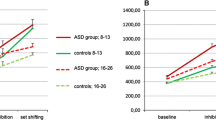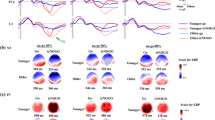Abstract
Resistance to distractor inhibition tasks have previously revealed impairments in children with autism. However, on the classic Stroop task and other prepotent response tasks, children with autism show intact inhibition. These data may reflect a distinction between prepotent response and resistance to distractor inhibition. The current study investigated this possibility using tasks that systematically manipulated inhibitory load. Findings showed that children with autism performed comparably to typically developing and learning disabled controls on a prepotent response inhibition stop-signal task but showed significant inhibitory impairment on a modified flanker resistence to distractor inhibition task. Although the results are clearly consistent with the suggestion that autism is associated with a specific deficit in resistance to distractor inhibition, they may in fact be related to an increased perceptual capacity in autism.




Similar content being viewed by others
References
Adams, N. C., & Jarrold, C. (2009). Inhibition and the validity of the Stroop task for children with autism. Journal of Autism and Developmental Disorders, 39, 1112–1121.
Ames, C. S., & Jarrold, C. (2007). The problem with using eye-gaze to infer desire: A deficit of cue inference in children with autism spectrum disorder? Journal of Autism and Developmental Disorders, 37, 1761–1775.
Bishop, D. V. M., & Norbury, C. F. (2005). Executive functions in children with communication impairments, in relation to autistic symptomotology. Autism, 9, 7–27.
Broadbent, D. E., Cooper, P. F., Fitzgerald, P., & Parkes, K. R. (1982). The cognitive failures questionnaire (CFQ) and its correlates. British Journal of Clinical Psychology, 21, 1–16.
Bryson, S. E. (1983). Interference effects in autistic children: Evidence for the comprehension of single stimuli. Journal of Abnormal Psychology, 92, 250–254.
Bunge, S. A., Ochsner, K. N., Desmond, J. E., Glover, G. H., & Gabrieli, J. D. E. (2001). Prefrontal regions involved in keeping information in and out of mind. Brain, 124, 2074–2086.
Burack, J. A. (1994). Selective attention deficits in persons with autism: Preliminary evidence of an inefficient attentional lens. Journal of Abnormal Psychology, 103, 535–543.
Christ, S. E., Holt, D. D., White, D. A., & Green, L. (2007). Inhibitory control in children with autism spectrum disorder. Journal of Autism and Developmental Disorders, 37, 1155–1165.
Christ, S. E., Kester, L. E., Bodner, K., & Miles, J. H. (in press). Evidence for selective inhibitory impairment in individuals with autism spectrum disorder. Neuropsychology.
Daneman, M., & Carpenter, P. A. (1980). Individual differences in working memory and reading. Journal of Verbal Learning and Behavior, 19, 450–466.
de Zubicaray, G. I., Andrew, C., Zelaya, F. O., Williams, S. C. R., & Dumanoir, C. (2000). Motor response suppression and the prepotent tendency to respond: A parametric fMRI study. Neuropsychologia, 38, 1280–1291.
Dempster, F. (1992). The rise and fall of the inhibitory mechanism: Toward a unified theory of cognitive development and aging. Developmental Review, 12, 45–75.
Dempster, F. N. (1993). Resistance to interference: Developmental changes in a basic processing dimension. In M. L. Howe & R. Pasnak (Eds.), Emerging themes in cognitive development. Vol. 1: Foundations (pp. 3–27). New York: Springer.
Eriksen, B. A., & Eriksen, C. W. (1974). Effects of noise letters upon identification of a target letter in a non search task. Perception and Psychophysics, 16, 143–149.
Eskes, G., Bryson, S., & McCormick, T. (1990). Comprehension of concrete and abstract words in autistic children. Journal of Autism and Developmental Disorders, 20, 61–73.
Fan, J., McCandliss, B. D., Sommer, T., Raz, A., & Posner, M. I. (2002). Testing the efficiency and independence of attentional networks. Journal of Cognitive Neuroscience, 14, 340–347.
Friedman, N. P., & Miyake, A. (2004). The relations among inhibition and interference control functions: A latent variable analysis. Journal of Experimental Psychology: General, 133, 101–135.
Garavan, H., Ross, T. J., & Stein, E. A. (1999). Right hemispheric dominance of inhibitory control: An event-related functional MRI study. Proceedings of the National Academy of Sciences, 96, 8301–8306.
Garon, N., Bryson, S., & Smith, I. (2008). Executive function in preschoolers: A review using an integrative framework. Psychological Bulletin, 134, 31–60.
Geurts, H., Luman, M., & van Meel, C. S. (2008). What’s in a game: The effect of social motivation on interference control in boys with ADHD and autism spectrum disorders. Child Psychology and Psychiatry, 49, 848–857.
Geurts, H., Verté, S., Oosterlaan, J., Roeyers, H., & Sergeant, J. (2004). How specific are executive functioning deficits in attention deficits in attention deficit hyperactivity disorder and autism? Journal of Child Psychology and Psychiatry, 45, 836–845.
Goldberg, M. C., Mostofsky, S. H., Cutting, L. E., Mahone, E. M., Astor, B. C., Denckla, M. B., et al. (2005). Subtle executive impairment in children with autism and ADHD. Journal of Autism and Developmental Disorders, 35, 279–293.
Griffith, E., Pennington, B., Wehner, E., & Rogers, S. (1999). Executive function in young children in autism. Child Development, 70, 817–832.
Harnishfeger, K. K. (1995). The development of cognitive inhibition: Theories, definitions, and research evidence. In F. N. Dempster & C. J. Brainerd (Eds.), Interference and inhibition in cognition (pp. 175–204). San Diego, CA: Academic Press.
Hasher, L., & Zacks, R. T. (1988). Working memory, comprehension, and aging: A review and a new view. In G. H. Bower (Ed.), The psychology of learning and motivation (Vol. 22, pp. 193–225). San Diego, CA: Academic Press.
Henderson, H., Schwartz, C., Mundy, P., Burnette, C., Sutton, S., Zahka, N., et al. (2006). Response monitoring, the error-related negativity, and differences in social behavior in autism. Brain and Cognition, 61, 96–109.
Hill, E. L. (2004). Evaluating the theory of executive dysfunction in autism. Developmental Review, 24, 189–233.
Iarocci, G., & Burack, J. (2004). Intact covert orienting to peripheral cues among children with autism. Journal of Autism and Developmental Disorders, 34, 257–264.
Johnston, K., Madden, A. K., Brahman, J., & Russell, A. J. (2011). Response inhibition in adults with autism spectrum disorder compared to attention deficit/hyperactivity disorder. Journal of Autism and Developmental Disorders, 41, 903–912.
Joseph, R. M., & Tager-Flusberg, H. (2004). The relationship of theory of mind and executive functions to symptom type and severity in children with autism. Development and Psychopathology, 16, 137–155.
Kane, M. J., Bleckley, M. K., Conway, A. R. A., & Engle, R. W. (2001). A controlled-attention view of working-memory capacity. Journal of Experimental Psychology: General, 130, 169–183.
Keehn, B., Lincoln, A. J., Müller, R.-A., & Townsend, J. (2010). Attentional networks in children and adolescents with autism spectrum disorder. Journal of Child Psychology and Psychiatry, 51, 1251–1259.
Lavie, N., Lin, Z., Zokaei, N., & Thoma, V. (2009). The role of perceptual load in object recognition. Journal of Experimental Psychology: Human Perception and Performance, 35, 1346–1358.
Lopez, B. R., Lincoln, A. J., Ozonoff, S., & Lai, Z. (2005). Examining the relationship between executive functions and restricted, repetitive symptoms of autistic disorder. Journal of Autism and Developmental Disorders, 35, 445–460.
Minshew, N., Luna, B., & Sweeney, J. (1999). Oculomotor evidence for neocortical systems but no cerebellar dysfunction in autism. Neurology, 52, 917–922.
Nigg, J. T. (2000). On inhibition/disinhibition in developmental psychopathology: Views from cognitive and personality psychology and a working inhibition taxonomy. Psychological Bulletin, 126, 220–246.
Ozonoff, S., & Jensen, J. (1999). Brief report: Specific executive function profiles in three neurodevelopmental disorders. Journal of Autism and Developmental Disorders, 29, 171–177.
Ozonoff, S., & Strayer, D. L. (1997). Inhibitory function in nonretarded children with autism. Journal of Autism and Developmental Disorders, 27, 59–77.
Ozonoff, S., Strayer, D. L., McMahon, W. M., & Filloux, F. (1994). Executive function abilities in autism and Tourette syndrome: An information-processing approach. Journal of Child Psychology and Psychiatry, 35, 1015–1032.
Plaisted, K., O’Riordan, M., & Baron-Cohen, S. (1998). Enhanced discrimination of novel, highly similar stimuli by adults with autism during a perceptual learning task. Journal of Child Psychology and Psychiatry, 39, 765–775.
Raven, J. C., Court, J. H., & Raven, J. (1990). Coloured progressive matrices. Oxford: Oxford Psychologists Press.
Remington, A., Swettenham, J., Campbell, R., & Coleman, M. (2009). Selective attention and perceptual load in autism spectrum disorder. Psychological Science, 20, 1388–1393.
Russell, J., Jarrold, C., & Hood, B. (1999). Two intact executive capacities in children with autism: Implications for the core executive dysfunctions in the disorder. Journal of Autism and Developmental Disorders, 29, 103–112.
Rutter, M., Bailey, A., & Lord, C. (2003). The social communication questionnaire. Los Angeles: Western Psychological Services.
Shallice, T. (1988). From neuropsychology to mental structure. Cambridge: Cambridge University Press.
Uhl, F., Podreka, I., & Deecke, L. (1994). Anterior frontal cortex and the effect of proactive interference in word pair learning: Results of Brain- SPECT. Neuropsychologia, 32, 241–247.
Wegner, D. M., & Zanakos, S. (1994). Chronic thought suppression. Journal of Personality, 62, 615–640.
Author information
Authors and Affiliations
Corresponding author
Rights and permissions
About this article
Cite this article
Adams, N.C., Jarrold, C. Inhibition in Autism: Children with Autism have Difficulty Inhibiting Irrelevant Distractors but not Prepotent Responses. J Autism Dev Disord 42, 1052–1063 (2012). https://doi.org/10.1007/s10803-011-1345-3
Published:
Issue Date:
DOI: https://doi.org/10.1007/s10803-011-1345-3




